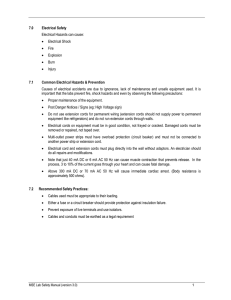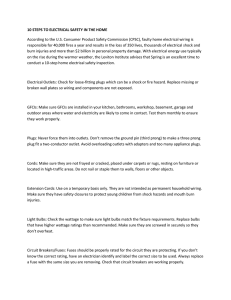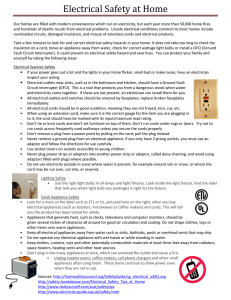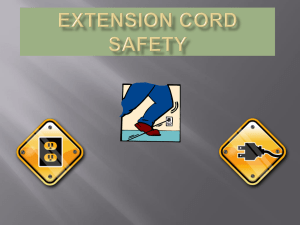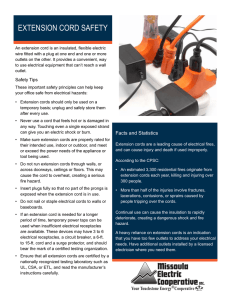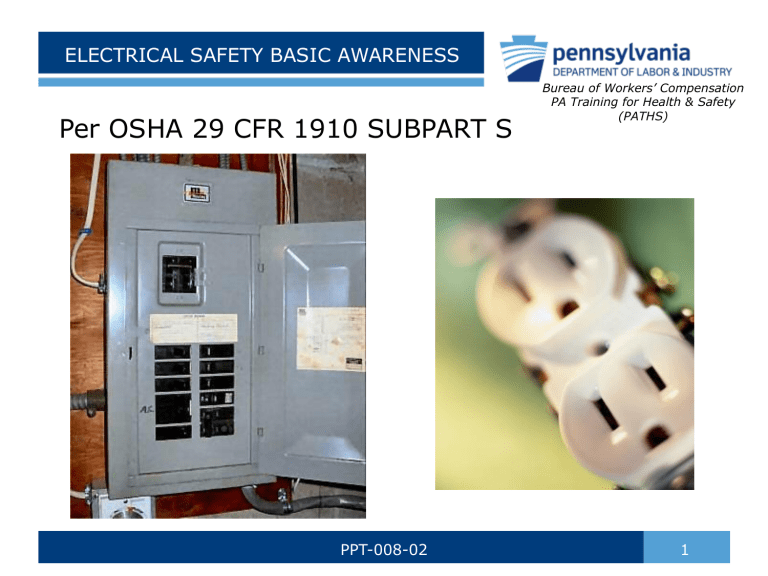
ELECTRICAL SAFETY BASIC AWARENESS Per OSHA 29 CFR 1910 SUBPART S PPT-008-02 Bureau of Workers’ Compensation PA Training for Health & Safety (PATHS) 1 Electrical Injuries AN AVERAGE OF ONE WORKER IS ELECTROCUTED ON THE JOB EVERY DAY! There are four main types of electrical injuries: • Electrocution (death due to electrical shock) • Electrical Shock • Burns • Falls PPT-008-02 2 Statistics U.S. Fire Administration US fire statistics on electrical fire causes (2002-2005) Factor contributing to ignition in reported structure fires Fires % unclassified electrical failure or malfunction 36,300 7 unspecified short circuit arc 21,400 4 short circuit arc from defective or worn insulation 11,400 2 arc or spark from operating equipment 4,000 1 arc from faulty contact or broken conductor 3,600 1 short circuit arc from mechanical damage 3,400 1 water caused short circuit arc 1,600 <1 PPT-008-02 3 How is an Electrical Shock Received? When two wires have different potential voltages current will flow if they are connected. • In most household wiring the black wires are at 110 volts relative to ground • The white wires are at zero volts because they are connected to ground Contact with an energized (live) black wire while touching the white grounded wire = ELECTRICAL SHOCK! PPT-008-02 4 Electrical Burns • Are the most common shock related nonfatal injury • Occur when you touch electrical wiring or equipment that is improperly used or maintained • Typically occurs on the hands • Very serious injury that needs immediate attention PPT-008-02 5 Falls • Electrical shock can also cause indirect or secondary injuries. • Employees working in an elevated location who experience a shock can fall resulting in serious injury or even death. PPT-008-02 6 Inadequate Wiring Hazards A hazard exists when a conductor is too small to safely carry the current. Example: using a portable tool with an extension cord that has a wire too small for the tool • Tool draws more current than cord can handle = overheating, possible fire without tripping the circuit breaker • Circuit breaker could be the right size for the circuit but not for the smaller wire extension cord PPT-008-02 7 Hazards of Overloading • Too many devices plugged into circuit = wires heat to very high temperature = possible fire. • Wire insulation melts = arcing may occur = fire in area where overload exists (even inside a wall). PPT-008-02 8 Electrical Protective Devices • Shut off electricity flow in the event of an overload or ground-fault in the circuit. • Include fuses, circuit breakers, and groundfault circuit interrupters (GFCI). • Fuses and circuit breakers are “over current” devices (too much current = fuses melt and circuit breakers “trip” open). PPT-008-02 9 Ground Fault Circuit Interrupter • Protects you from dangerous electrical shock. • Detects a difference in current between the black and white circuit wires (could happen when electrical equipment is not working properly causing a current “leakage” known as ground fault). • Ground fault detected = GFCI can shut off electricity flow in as little as 1/40 of a second protecting you from a dangerous shock. PPT-008-02 10 Examples: OSHA Electrical Requirements GROUNDING PATH The path to ground from circuits, equipment, and enclosures must be permanent and continuous. The violation shown here is an extension cord with the third/grounding prong missing. PPT-008-02 11 Examples: OSHA Electrical Requirements • Hand-held electrical tools pose a potential danger because they make continuous contact with the hand. • To protect you from shock, burns, and electrocution, tools must: o Have a 3 wire cord with ground and be plugged into a grounded receptacle or o Be double insulated or o Be powered by a low-voltage isolation transformer PPT-008-02 12 Guarding Live Parts Must guard “live” parts of electric equipment operating at > 50 volts against accidental contact by: • Approved cabinets/enclosures or • Location or permanent partitions (thereby only accessible to qualified persons) • Elevation of 8 feet or more above the floor or working surface • Mark entrances to guarded locations with conspicuous warning signs PPT-008-02 13 Guarding Live Parts • Where electrical equipment is in locations that it can suffer physical damage it must be guarded. • The violation shown here is physical damage to conduit. PPT-008-02 14 Cabinets, Boxes, Fittings • Junction boxes, pull boxes, and fittings must have approved covers. • Unused openings in cabinets, boxes and fittings must be closed (no missing “knockouts”). • Photo shows violations of these two requirements. PPT-008-02 15 Use of Flexible Cords • Are more vulnerable than fixed wiring. • Made be of industrial commercial quality. • May not be used as permanent wiring. • Improper use of flexible cords can cause shocks, burns, or fire. • Approved by a recognized testing agency. PPT-008-02 16 Flexible Cords • Uncoil an extension cord fully before use. • Be sure the amperage of the cord is appropriate for the job you are doing. • Do not use equipment that delivers mild electrical shocks, gives off unusual heat or smells odd. • If in doubt, have it checked and repaired or replaced. PPT-008-02 17 Flexible Cords Extension cords shall not be fastened with staples, hung from nails, or suspended by wire. PPT-008-02 18 Permissible Uses of Flexible Cords Examples Pendant or Fixture Wiring Portable lamps, tools or appliances PPT-008-02 Stationary equipment to facilitate interchange 19 Prohibited Uses of Flexible Cords Examples Substitute for fixed wiring Run through walls, ceilings floors, doors, or windows PPT-008-02 Concealed behind or attached to building surfaces 20 Electrical Extension Cords Homemade “Gang Box” Not allowed in work setting per OSHA: 29 CFR 1910.305 29 CFR 1926.405 PPT-008-02 21 Unsafe PPT-008-02 22 Unsafe PPT-008-02 23 Unsafe PPT-008-02 24 Unsafe PPT-008-02 25 Unsafe PPT-008-02 26 Unsafe PPT-008-02 27 Unsafe PPT-008-02 28 Top 5 – Electrical Fire Causes 1. Most electrical fires are caused by faulty electrical outlets and old, outdated appliances. Removing the grounding plug from a cord so it can be used in a two-prong electrical outlet can also cause a fire. PPT-008-02 29 Top 5 – Electrical Fire Causes 2. Light fixtures, lamps and light bulbs are another common reason for electrical fires. o Installing a bulb with a wattage that is too high for the lamps and light fixtures is a leading cause of electrical fires. o Always check the maximum recommended bulb wattage on any lighting fixture or lamp and never go over the recommended amount. PPT-008-02 30 Top 5 – Electrical Fire Causes 3. Misuse of extension cords is another electrical fire cause. o Appliances should be plugged directly into outlet and not plugged into an extension cord for any length of time. o Only use extension cords as a temporary measure. o If you do not have the appropriate type of outlets for your appliances, hire an electrician to install new ones. PPT-008-02 31 Top 5 – Electrical Fire Causes 4. Space heaters are a major cause of electrical fires. o Because these types of heaters are portable, many times people put them too close to combustible surfaces such as clothing, chairs, and rugs. o Coil space heaters are especially dangerous. I o f you do use space heaters, use the radiator-type that diffuse heat over the entire surface of the appliance. PPT-008-02 32 Top 5 – Electrical Fire Causes 5. Outdated wiring often causes electrical fires. o Breakers should be triggered when circuits get overloaded by too much electricity, o Outdated breaker boxes often have worn connectors that do not work, causing the system to overload and start an electrical fire. PPT-008-02 33 Safety • Check the information on your cord. o Extension cords are labeled with valuable information as to the use, size and wattage rating of the cord. o Cords offered in many lengths and are labeled with size or “gauge.” • Determine the gauge needed. All appliances indicate how much wattage is consumed when operated. PPT-008-02 34 Safety • Decide whether you will be using the appliance indoors or outdoors. o Extension cords that can be used outdoors will be clearly marked “Suitable for Use with Outdoor Appliances.” • Never use an indoor extension cord outdoors; it could result in an electric shock or fire hazard. PPT-008-02 35 Safety • Determine how long you need the cord to be. A cord, based on its gauge, can power an appliance of a certain wattage only at specific distances. o As cord gets longer, the current carrying capacity of the cord gets lower. o Example: 16 gauge extension cord less than 50 feet in length can power a 1625 watt (W) appliance; 16 gauge cord that is longer than 50 feet can only power an appliance up to 1250W. PPT-008-02 36 Safety Place the cord correctly. o Do not place underneath carpets or heavy furniture. o Should not be tacked in place to a wall or taped down. o Should not be used while coiled or bent. o Match the length of the cord to the length of your needs. PPT-008-02 37 Training Train employees working with electrical equipment in safe working practices including: • De-energizing electrical equipment before inspecting or making repairs • Using electric tools in good repair • Using good judgment when working near energized lines • Using appropriate protective equipment (PPE) PPT-008-02 38 Summary • Extension cords must be "of proper size and temperature rating to withstand the electrical load and approved by a recognized testing agency.” • Locally purchased extension cords may not meet this standard. • Always check applicable regulations/standards before buying or using extension cords at work. PPT-008-02 39 Summary Hazards • Inadequate wiring • Exposed electrical parts • Wires with bad insulation • Ungrounded electrical tools/systems • Overloaded circuits • Damaged power tools/equipment • Overhead power lines All hazards are made worse in wet conditions! PPT-008-02 40 Summary PROTECTIVE MEASURES ▪ Proper grounding ▪ Using GFCI’s ▪ Using fuses and circuit breakers ▪ Proper use of flexible cords ▪ Training PPT-008-02 41 Contact Information Health & Safety Training Specialists 1171 South Cameron Street, Room 324 Harrisburg, PA 17104-2501 (717) 772-1635 RA-LI-BWC-PATHS@pa.gov Like us on Facebook! https://www.facebook.com/BWCPATHS PPT-008-02 42 Questions PPT-008-02 43
